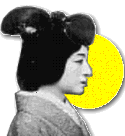"When you have completed 95% of your journey, you are halfway there." ~ Japanese Proverb
 Life's journey is a celebration of simple pleasures. Life's journey is a celebration of simple pleasures.
In Asia, tea is more than just a national drink. A symbol of welcome and the benchmark of hospitality, tea is honored by the Japanese who call it o-cha, meaning "respected tea."
"Be beautiful if you can, wise if you want to, but be respected that is essential," observed Anna Gould.
The tea ceremony, a special celebration of the hot, fragrant beverage, is the heart of Japanese culture. Famous tea master Sen no Rikyu (1521-1591) transformed the tea ceremony, chanoyu, the Way of Tea, into the intimate gathering of modesty and refinement that it is today.
Sen no Rikyu's aesthetic rituals was a delightful respite from the busy and sometimes violent world outside. His gathering place evolved into the traditional tea room: small and simple, made of natural materials such as bamboo and wood, paper windows, and floor covered with tatami mats--mats of woven straw. The mood was quiet, with muted light. Nonessentials were eliminated so that simplicity could lead to clarity.
"The ability to simplify means to eliminate the unnecessary so that the necessary may speak," said artist Hans Hoffman.
Part of the joy of tea drinking was, and continues to be, the journey of life's small pleasures and inner harmony.
 Honor life's journey. Honor life's journey.
|